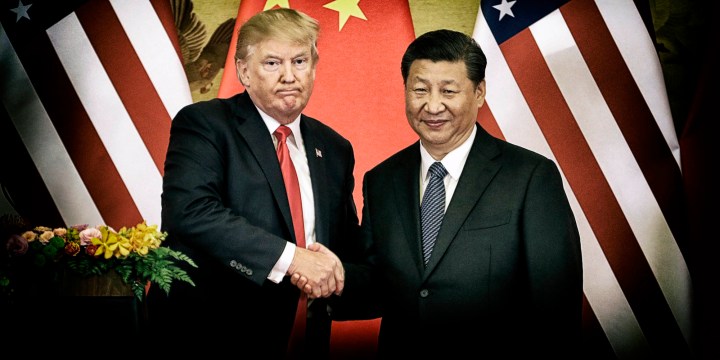BUSINESS MAVERICK: OP-ED
Commodities grapple with the post-trade deal outlook

Initial excitement around the signing of the US-China Phase 1 trade deal has settled into circumspection about whether the Chinese commodity spending targets are achievable. Most commodity prices, including oil, have edged back from their peaks, but palladium continues to soar on environmental considerations and supply constraints.
The official signing of a US-China Phase 1 trade deal has lifted the veil of uncertainty that has shrouded financial and commodity markets for the last couple of years. However, its long-awaited signing hasn’t cleared the air completely.
The consensus is that the $200-billion in goods and services and $95-billion in commodities spending targets China has agreed to, and a much-anticipated Phase 2 deal, will be difficult, if not unrealistic, to achieve.
The US deliberately kept tariffs on Chinese imports in place to ensure Phase 2 negotiations are taken seriously. However, there is a great deal of scepticism about whether the key issues that need to be resolved, including removing the web of state subsidies that support Chinese companies, will happen anytime soon.
UBS Global Wealth Management Chief Economist Paul Donovan points out that three things will not change after signing the trade deal. “First, supply chains involving China have shifted. Over half the Chinese products subject to September 2018 tariffs have had a noticeable drop in US market share. Supply chains are unlikely to shift back. Second, trade will stay a political issue. ”
Thirdly, he doesn’t expect a revival in investment. “This deal is not enough to create certainty. Investment may rise as companies maintain what they have, but big investment spending seems unlikely.”
The initial excitement surrounding the signing of the deal soon turned to caution, as witnessed in commodity prices, like copper, which gained about 2.5%, but then retreated 0.5% from its post-deal peak. Year to date, the metal price has risen 2.2%, not far off its full-year advance of 3.4% during 2019.
China is a top consumer of copper and thus the metal price is highly dependent on the state of the Chinese economy. Initial indicators are reasonably encouraging for the metal. This week’s gross domestic product (GDP) figures for the fourth quarter showed growth had stabilised, coming in at 6%. This performance was viewed as confirming that the government’s stimulatory measures are having some success. For the year as a whole, the Chinese economy grew 6.1% year on year, in line with expectations.
Crude oil has been relatively volatile this year, given the eventful start to the year, when the US assassinated Iranian major general Qasem Soleimani. This week, supply disruptions in Iraq and Libya have also affected the price.
However, compared with past responses to geopolitical risks such as these, the oil price reaction has been muted, quickly giving up the ground gained in response to the geopolitical risk. For instance, crude oil prices have come off 7% since WTI (West Texas Intermediate, the American oil benchmark), jumped to $63.54 a barrel in response to the US attack and, at $58.98, are a mere 3% higher for the year to date.
The commodity’s price performance highlights that geopolitical events are having less of an impact on the oil price than fundamental factors, such as supply and demand dynamics. OECD concerns about oversupply in the first half of the year remain in place and thus oil prices are likely to remain subject to downward pressure in the absence of a solid pick up in global growth. Also, as Donovan says: “Although the world consumes more oil than in the past, it takes less oil to produce a unit of economic output than in the past. This reduces the economic consequences of oil price changes.”
The one commodity that has been shooting the lights out this year, in a continuation of its impressive gains last year, is palladium. In what is beginning to look like an exponential increase in the palladium price, the metal’s price has increased by a third in the first 20 days of 2020 after advancing more than 50% last year. These gains highlight the increasing focus on environmental issues, with palladium in huge demand as a key component in the auto industry responsible for reducing vehicle emissions.
Nowhere are climate change and environmental challenges likely to be more evident than at this week’s World Economic Forum, where these issues are set to dominate the conversation between world leaders and global industry stalwarts.
ING says the year to date price gains in palladium’s price may be a result of a short-squeeze as the physical market for the metal continues to tighten. SA supply challenges are likely contributing. Latest mining statistics show the production of platinum group metals fell by a sharp 13.5% year on year in November 2019, a month during which the industry was beset by electricity outages.
“Further disruptions to supply cannot be ruled out, with the mining industry still facing frequent and unscheduled power outages,” says ING. “While higher prices should be encouraging miners to look to boost output, palladium is largely produced as a by-product, making supply more inelastic.”
With supply constraints unlikely to ease in the near future and environmental challenges likely to remain top of mind, palladium prices could well continue their three-year winning streak. The metal has been the top of the commodity price leader board since 2017.
Last year, most commodity prices were all over the place, largely in response to the on-again, off-again US-China trade talks. Although the Phase 1 deal is not seen as a panacea for the global commodity trade, it does remove trade tensions between the two powerhouses from the headlines, for now, giving fundamentals more of a chance to reassert themselves during 2020. BM




















 Become an Insider
Become an Insider